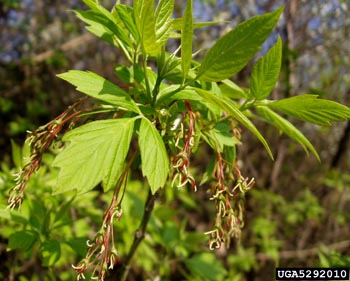Boxelder

Common Name(s):
Boxelder
Ashleaf Maple
Scientific Name:
Acer negundo L.
Scientific Name Synonyms:
None known
Symbol:
ACNE2
Description:
Life Span: Perennial
Origin: Native
Season: Deciduous
Growth Characteristics: A medium-sized tree with an irregular form, averaging 45 feet in height and about 24 inches in diameter. The crown is very dense, broad, and rounded, usually extending from the ground up. It flowers March to May and reproduces from seed and root sprouting.
Fruits/Seeds: Fruits are paired samaras hanging in clusters. Each seed pair is about 1 ½ inches long. They hang in long chains on slender stalks, mature in autumn, and remain on the tree well into the winter.
Flowers/Inflorescence: Yellow-green flowers appear in dense clusters with the leaves in early spring. They are small, ¼ inch in diameter. The male and female flowers are separate. The male flowers are on slender stalks in loose clusters. The female flowers are arranged along a separate stem.
Leaves: Appear in opposite pairs; about 6 inches long, each divided into 3 to 7 leaflets that are along the central leaf stalk. Boxelder is the only member of the maple family that has divided leaves. Each leaftlet is coarsely toothed to lobed and about 3 inches long. The leaf color is dull green through the summer, turning yellow as they drop in the fall. Buds are nearly ¼ inch long and hairy.
Stems: Twigs light green to purplish brown, usually with velvety white hairs, but sometimes hairless. Trunk bark is yellow brown to light gray and smooth, furrowed with narrow ridges, becoming darker with age. Scars left by winter buds encircle the twigs, meeting in raised points on opposite sides of the twigs. Buds are white hairy with blunt tips.
Ecological Adaptions:
The form of boxelder found in Utah is a variety of the species that is widely distributed throughout the United States. Boxelder is common on moist sites along lakes and streams, on floodplains, and in low-lying wet places where its shallow root system can find abundant moisture. It is found mostly between 4,000 and 8,000-foot elevations. It is drought tolerant once established, and can also withstand short periods of flooding.
Soils: Boxelder can tolerate a wide variety of soils, but shows a strong preference for well-drained, moist soils, usually with a medium to rocky texture.
Associated Species: Willow, narrowleaf cottonwood, aspen, chokecherry.
Uses and Management:
Boxelder provides ground cover, streambank protection, and shade for livestock and recreation areas in lower portions of Utah canyons.
Boxelder is a rapidly growing tree, resulting in weak and brittle wood at maturity. The wood has been used as a source of fuel, and small amounts may have been used for poles and rough lumber. In other parts of the country, wood of this species is utilized in the furniture industry where low quality wood is adequate.
Boxelder is easily injured by heart rot, fire, and insects. It is often infested with boxelder bugs, which feed on the tree, but rarely kill it.
The burls and knots on the lower trunk are fine grained, and were used by Native Americans for bowls, dishes, pipestems, and drums. The inner bark was boiled into a tea that was used as an emetic.

